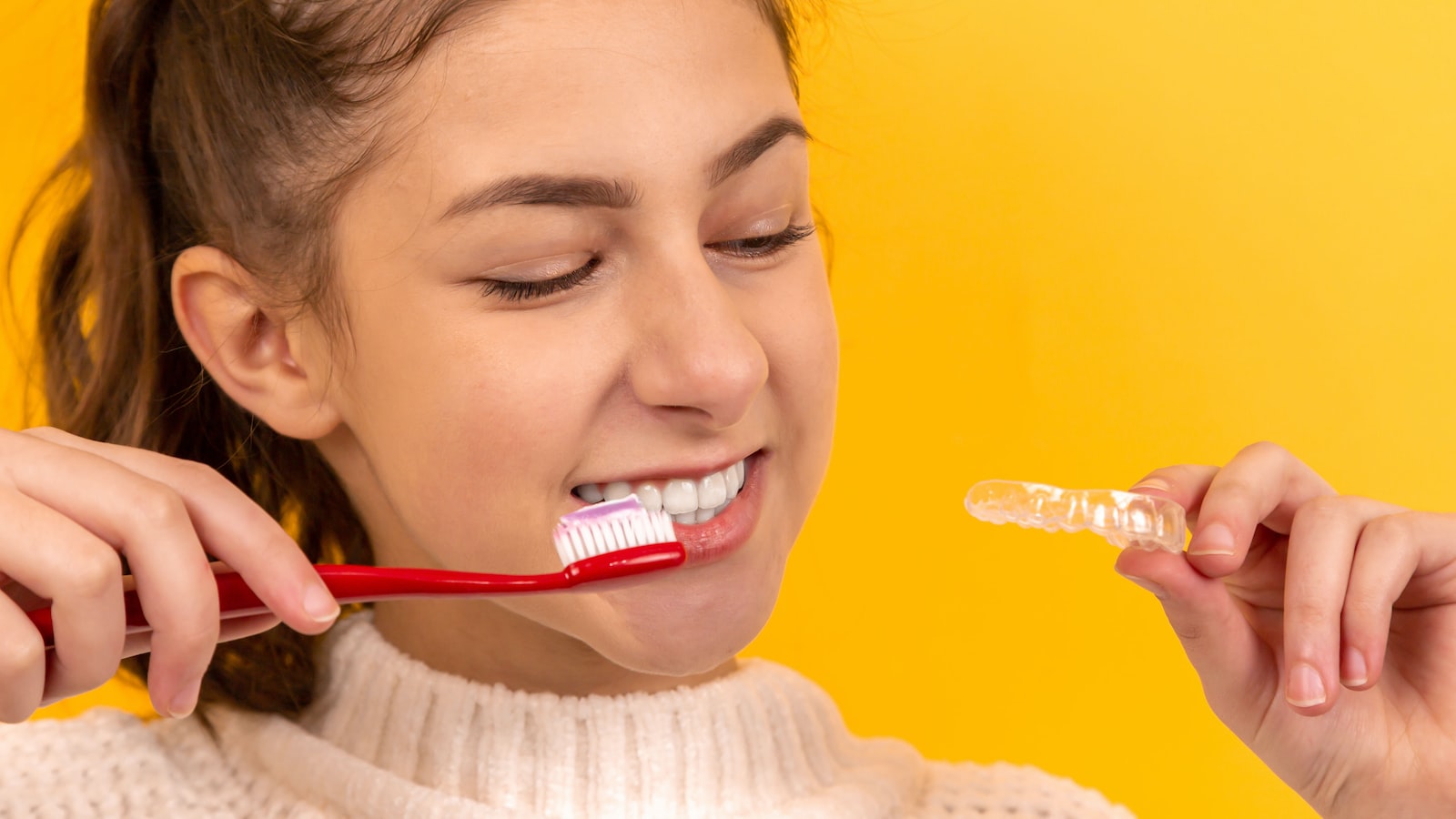Is It Bad To Wear A Retainer That Doesn’t Fit

If you wear a retainer that does not fit properly, it can cause problems for your teeth. Wearing an ill-fitting retainer can cause pain, discomfort, and even permanent damage to your teeth and gums. It is important to make sure that you have a retainer that fits properly in order to maintain the health of your teeth. In this article, we will discuss the risks associated with wearing a retainer that does not fit correctly and what you can do to ensure that you have a proper fitting retainer.Yes, it is bad to wear a retainer that doesn’t fit. Wearing a retainer that doesn’t fit can lead to discomfort, pain, and in some cases even damage your teeth. When a retainer doesn’t fit correctly, it can cause your teeth to move back into their original positions, which defeats the purpose of wearing a retainer in the first place. Additionally, poorly fitting retainers can also cause mouth sores and damage to the gums.
What Are The Risks Of Wearing A Poorly Fitting Retainer?
Wearing a poorly fitting retainer can lead to a number of risks. Poorly fitted retainers can cause gum irritation and can lead to pain in the mouth because they may not fit properly. If the retainer is too tight, it can cause gum recession and tooth shifting, while if it is too loose, it may not provide adequate retention to keep teeth in place. Poorly fitting retainers may also cause abrasion on the teeth or gums if they are not adjusted appropriately. In addition, food particles and bacteria can get trapped under the retainer, leading to increased risk for tooth decay and bad breath.
It is important to have the retainer fitted by an orthodontist or dentist so that it fits properly and does not cause any of these risks. If your retainer does not fit correctly, make sure to contact your orthodontist or dentist immediately to have it adjusted or replaced. With proper care and maintenance, you can minimize any risks associated with wearing a poorly fitting retainer.
How To Tell If Your Retainer Is Not Fitting Properly
Retainers are an important part of keeping your teeth straight after orthodontic treatment, but sometimes they can stop fitting properly. If this happens, it can cause discomfort and even damage your teeth if not addressed. Fortunately, there are a few telltale signs to help you know when your retainer is not fitting correctly.
One of the most common signs that a retainer is not fitting properly is increased discomfort or pain in the mouth. This can be caused by the retainer pressing too firmly against the teeth and gums, or from misalignment of the appliance. If you experience this type of discomfort while wearing your retainer, it’s important to contact your orthodontist right away for an adjustment or replacement.
Another sign that a retainer is not fitting properly is visible gaps between the teeth and the retainer. This can be caused by improper sizing or by wear and tear on the appliance over time. If you notice any gaps between your teeth and your retainer, it’s best to contact your orthodontist for an adjustment or replacement as soon as possible.
Finally, if you notice that your teeth have started to shift out of their original alignment, this could mean that your retainer is not fitting correctly anymore. This could be due to misalignment of the device itself or due to wear and tear on the appliance over time. It’s important to contact your orthodontist immediately if you notice any changes in the alignment of your teeth so that they can make adjustments or replace the device as necessary.
Retainers are an important part of keeping our teeth straight after orthodontic treatment, so it’s important to pay attention to any signs that yours might not be fitting properly anymore. If you experience increased discomfort in your mouth while wearing a retainer, see visible gaps between your teeth and the device, or notice changes in the alignment of your teeth, contact an orthodontist right away for an adjustment or replacement so that you can keep enjoying a healthy smile!
What Should You Do If Your Retainer Does Not Fit?
If your retainer does not fit properly, it is important to take action immediately. A retainer that does not fit correctly can cause a variety of problems, from discomfort to tooth movement. To ensure your retainer fits properly, you should visit your orthodontist for an adjustment.
Your orthodontist can determine if the retainer needs to be remade or if it can be adjusted. If adjustments are necessary, they may involve reshaping the material or adding additional material in order to make it fit better. The orthodontist may also adjust the fit by changing the wire or adding a spacer in order to provide more room for the teeth and gums.
In some cases, a new retainer may need to be made if the existing one cannot be adjusted. Depending on how much time has passed since your last fitting, your orthodontist may recommend that you have a new fitting to get an accurate measurement of your teeth and mouth structure. This will help ensure that the new retainer fits properly and comfortably.
Once you have a new retainer or an adjusted one, it is important to wear it as directed by your orthodontist in order to maintain proper alignment of your teeth and jaw structure. It is also important to keep up with regular checkups so that any changes or adjustments to the retainer can be made as needed in order to maintain its proper fit and function.
If you notice any discomfort or difficulty when wearing the retainer, you should contact your orthodontist right away so that any necessary adjustments can be made in order to make sure it fits properly and comfortably. Taking care of any issues with an ill-fitting retainer quickly is key for maintaining good oral health and keeping your smile looking its best!
Signs of an Ill-Fitting Retainer
Having a retainer is an important part of maintaining your orthodontic treatment, but it’s only effective if it fits properly. Poorly fitting retainers can cause pain and discomfort, and may even damage your teeth or gums. If you’re unsure whether your retainer fits correctly, here are some signs to look out for:
Pain or discomfort when wearing the retainer – If you’re feeling any pain when wearing your retainer, this could be a sign that it’s not fitting correctly. It should fit snugly but not tightly, so if it’s causing any pain or discomfort then you should speak to your orthodontist.
Marks on the roof of your mouth – If you find that the retainer is leaving red marks on the roof of your mouth after wearing it, this could mean that it’s too tight. You should also make sure that the edges are smooth and there are no sharp parts that could be causing irritation.
Gaps between teeth – If the retainer isn’t fitting properly then this could lead to gaps developing between teeth as they move out of alignment. This can cause problems in terms of both aesthetics and oral health, so if you notice any changes in your bite then you should book an appointment with your orthodontist.
Difficulty speaking – Poorly fitting retainers can also make it more difficult to speak clearly, as they can interfere with the way the tongue moves in the mouth when forming words and sounds. If you find yourself having difficulty speaking while wearing the retainer then this could be a sign that it needs adjusting or replacing.

How To Adjust Your Retainer To Fit Better
Retainers are designed to fit your mouth perfectly, but if you’ve recently had your teeth adjusted, it may be necessary to adjust your retainer to fit better. Fortunately, this is a relatively simple process that can be done at home with the right tools and supplies. Here’s how to adjust your retainer to fit better:
Start by purchasing a retainer adjustment kit from your local pharmacy or online. This kit will come with everything you need, including wax and a molding bar. Once you have the kit in hand, put the retainer in warm water for about 10 minutes to make it more pliable.
Next, use the molding bar included in the adjustment kit to gently push the plastic of your retainer into any areas that are too loose or not fitting correctly. Make sure not to push too hard as this could damage the retainer. Once you’re finished molding the plastic, remove it from your mouth and check for any gaps or loose areas. If there are any present, take some of the wax included in the kit and fill them in.
Finally, put the retainer back in your mouth and press down gently on all sides. This will help ensure that it fits correctly and won’t move around while you wear it. Once you’re done adjusting your retainer, make sure to brush it off with cold water before putting it back in its case for storage.
Adjusting your retainer at home can be simple if you have all of the necessary supplies handy. Just remember to take things slowly and use gentle pressure when molding or pressing down on the plastic of your retainer – otherwise, you could end up causing damage!
How Long Does It Take For A Retainer To Become Uncomfortable?
Most people find that they become accustomed to wearing their retainer within a few days of getting it. However, the amount of time it takes for a retainer to become uncomfortable can vary from person to person. Generally, if you are experiencing discomfort or pain when wearing your retainer after a few days, it is likely due to the fit of the device. If this is the case, it is important to visit your orthodontist as soon as possible so that they can adjust the retainer and ensure that it fits properly.
In some cases, people may find that their retainers become uncomfortable after a few weeks or even months of use. This can be due to changes in your mouth as your teeth move into their desired positions. As your teeth shift, the shape of your mouth and jaw may also change slightly which can cause discomfort when wearing a retainer that was originally fitted correctly. If this happens, you should speak with your orthodontist about having your retainer refitted so that it is more comfortable to wear.
Overall, most people find that their retainers become comfortable within a few days of getting them fitted by an orthodontist. However, if you experience any discomfort or pain when wearing your retainer after a few days or weeks, you should make an appointment with your orthodontist so that they can adjust the fit if necessary and ensure proper comfort when wearing the device.
The Benefits Of Wearing A Properly Fitting Retainer
Retainers are an important part of orthodontic treatment, as they help to keep teeth in their newly aligned position and prevent them from shifting back to their previous state. Wearing a properly fitted retainer is essential for maintaining the results of orthodontic treatment, and there are several advantages that come with wearing one.
The first benefit of wearing a retainer is that it helps to preserve the results of orthodontic treatment. By keeping the teeth in their newly aligned positions, retainers help to prevent them from shifting back to their original state. This can help to improve the overall appearance of the smile and ensure that it remains attractive for longer.
Another benefit of wearing a properly fitting retainer is that it can help to reduce discomfort caused by misaligned teeth. When teeth are not in their proper positions, they can put pressure on surrounding tissues, which can cause pain and discomfort. Wearing a retainer helps to keep the teeth in their correct positions, reducing any associated discomfort.
Finally, retainers can also help to improve overall oral health by ensuring that the teeth are kept in proper alignment. Properly aligned teeth make it easier for people to brush and floss effectively, which helps to reduce the risk of tooth decay and gum disease. In addition, properly aligned teeth also allow for more even wear on the enamel, which helps protect against premature tooth erosion.
Wearing a properly fitting retainer has many benefits for those who have had orthodontic treatment or who suffer from misaligned teeth. By helping to preserve the results of treatment, reduce discomfort caused by misalignment, and improve overall oral health, retainers can be an important part of maintaining a healthy smile for years to come.

Conclusion
Wearing a retainer that doesn’t fit can have some serious consequences, including difficulty speaking and eating, discomfort, and changes to the alignment of the teeth. It can also lead to physical problems, such as pain in the jaw joint and damage to the teeth. While it is understandable that someone may be tempted to wear an ill-fitting retainer due to cost or convenience, it is important to take the time to make sure that the retainer fits properly. If not, then it is best to seek advice from a dentist or orthodontist who can provide a better-fitting option.
Ultimately, wearing a retainer that doesn’t fit can have long-term negative effects on oral health. Taking the time and resources needed to ensure that the retainer fits correctly can help avoid these issues and provide peace of mind.
